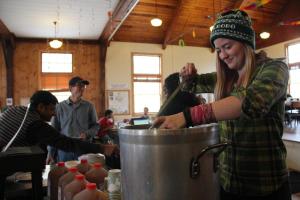Apple daze
Some reflections from freshman Shannon Haaland on the annual tradition known as Apple Days, which mysteriously lasts only one day.

It’s a Wednesday morning in the Marlboro dining hall, and everything would appear normal, except for the row of apple cider cartons placed by the register and a tray of apples with sticks in them, ready to be dipped in caramel. Travis Wilmot, a senior, sits back in a wooden dining hall chair and grumbles to me about his lack of knowledge on the names of apples, something he feels is crucial for an inhabitant of Vermont to know.
Outside, the yellow beech trees and the reds of maples stand out against the pale, cloudy sky. Students stand around an apple press, taking turns pulling a crank in order to make more apple cider. It takes roughly 36 apples to make just one gallon of apple cider, we find.
Apple trees are a part of Marlboro. The trees are left over from when Marlboro was a collective of two farms. Today they still produce thick harvests of apple on campus each autumn. Slipping on fallen fruit while running late to class is bound to happen at least once, and serves almost as a rite of passage. Students can be seen encircling trees, pointing out which apple looks the most delicious, and then proceeding on a hunt to capture it.
Eating apples is not only an enjoyable tradition, but one that can aid students on their paths of academia. Apples contain boron, which is responsible for the plants’ germination, and can also stimulate the brain and help increase mental alertness. Apple Days is a day to celebrate the campus residents, student and fruit alike, and the reminiscences of fall.
